Since Halloween is a few weeks away I was talking to a friend recently about our favorite horror films and I have to confess I’ve got a bunch. Most of them I first encountered as a kid watching on our black and white TV (three channels all of which went off the air with the playing of the National Anthem at midnight and didn’t start again until 7am): Them!, Curse of the Demon, Bride of Frankenstein, and The Haunting are on my list. When I was a little older I fell in love with the Hammer films including Horror of Dracula, The Mummy, Five Million Years to Earth, and Curse of the Werewolf among others; I wouldn’t exactly call all of them great filmmaking, especially the later ones in the early 1970s, but they were exciting, entertaining, colorful, and the actresses—like Ingrid Pitt, Caroline Munro, and Veronica Carlson in their sheer nightgowns or low-cut bustiers—made my heart beat faster and put a lump in my, uh…throat. I was never a fan of slasher or zombie movies or those that worked overtime to gross me out, but I do quite like some more recent films like Brotherhood of the Wolf, Crimson Peak, and The Witch. And I admit I’m interested in the remake of Nosferatu coming up: we’ll see. But…back to what is, I think, my favorite horror movie and that would be:
The Thing From Another World.
Produced by the legendary Howard Hawks and directed by Christian Nyby from an extremely tight 90-minute script by Charles Lederer (with uncredited rewrites by Hawks and Ben Hecht), The Thing From Another World featured snappy, overlapping dialogue (a Hawks trademark), a moody score by Dimitri Tiomkin, and an excellent cast of character actors including Margaret Sheridan, Kenneth Tobey, Robert Cornthwaite, Douglas Spencer, and William Self (the grandfather of our late friend Bob Self); James Arness played The Thing. The film was very loosely based on the novella “Who Goes There?” by Don A. Stuart which had appeared in the August, 1938 issue of Astounding Science Fiction magazine; “Don A. Stuart” was the pseudonym of the magazine’s new editor John W. Campbell Jr.
Above: The opening pages from the story’s first publication in Astounding Science Fiction in 1938.
Campbell, as many know, has become something of a controversial figure recently (even though he’s been in the ground for 53 years). As a writer and the editor of Astounding, Unknown Worlds, and finally Analog, John W. Campbell Jr. [1910-1971] unquestionably helped to shape the field of science fiction and fantasy literature in its early days; he published the first works by Isaac Asimov, Robert Heinlein, Theodore Sturgeon, and A.E. Van Vogt while discovering, encouraging, and nurturing many, many others. But at the same time he was overbearing, pompous, bullying, and, in the opinions of many who knew him well, a bigot, misogynist, and all-around rather nasty crank. And that’s being polite.
He was an unapologetic segregationist, a critic of government regulation of health and safety (sneering at, for example, the Surgeon General’s warnings about smoking in his editorials), a promoter of all manner of pseudoscience including ESP and Kirlian photography (and until they had a falling out worked closely with L. Ron Hubbard on the techniques that Hubbard later turned into Dianetics), and was vocally contemptuous of the Civil Rights Movement. According to Michael Moorcock, Campbell once insisted during a convention panel that “some people” actually preferred slavery and on more than one occasion suggested that other races were intellectually inferior. Yesh. His behavior and prejudices literally drove many of the writers he had discovered—who had also been his friends—away. Damon Knight (the author of “To Serve Man” and founder of the Science Fiction & Fantasy Writers of America) wrote, “Campbell’s lecture-room manner was so unpleasant to me that I was unwilling to face it. Campbell talked a good deal more than he listened, and he liked to say outrageous things.” While Alfred Bester (the author of The Demolished Man and The Stars My Destination) said about his “one demented meeting” with the editor, “It reinforced my private opinion that a majority of the science-fiction crowd, despite their brilliance, were missing their marbles.”
Above:Who Goes There? was the title and featured story in a collection of Campbell’s fiction published in 1948 by Shasta Publishers in an edition of 3,000 copies. The classic cover is by Hannes Bok.
Regardless of his views and reputation, Dell Magazines, at the time the publisher of Analog, founded the John W. Campbell Award for Best New Writer as an acknowledgement of his importance and legacy in 1973. It was presented annually during the Hugo Awards ceremony at the World Science Fiction Convention without many, if any, complaints (as far as I know) until 2019 when winner Jeannette Ng described Campbell as a “fucking fascist” in her acceptance speech, saying “pulling down memorials to dead racists is not the erasing of history, it is how we make history.” Whether Campbell was actually a fascist is open to debate (while his being racist was pretty well established), but Ng’s comments certainly resonated with a new generation of science fiction fandom and, following lively discussions, the editor of Analog, Trevor Quachri, announced that the award had been renamed to the Astounding Award for Best New Writer.
None of which changes the fact that Campbell wrote a classic sf/horror story, one that became the basis of not one but two classic films, including my favorite. Mentioning the John W. Campbell Jr. controversy is merely trying to provide some context: as I’ve said in the past, life is messy, people are complicated, and we only learn from history if we’re willing to face it honestly. The “bad” doesn’t wipe out the “good” or vice versa…at least it shouldn’t. Asshat Campbell may very well have been, but I can separate the asshat from the work.
Above: Shasta reprinted Who Goes There? under the title of The Thing From Another World to capitalize on the film’s release in 1951 with this new cover is by Malcolm Smith.
Anyway, back to the cinema: Admittedly the Lederer/Hawks/Hecht script diverted greatly from its source. In Campbell’s novella the invading alien is a shapeshifting skinwalker, capable of assuming the physical and mental characteristics of any living thing it encounters; the movie depicts it as a humanoid creature whose cellular structure is much closer to vegetation, although it feeds on blood to survive. Campbell’s saucer had crashed on Earth 20 million years earlier in the Antarctic while Lederer’s UFO is a new arrival tracked by an Arctic research team on radar.
The film goes on to tell the story of an American Air Force crew sent to help the remote group of scientists investigate their sighting; to their shock they find a crashed flying saucer and frozen body nearby. Returning to their outpost with the corpse in a block of ice, they suddenly find themselves in a life-and-death battle with the still-alive and deadly space vampire when it’s thawed out by accident. The plant-like structure of the creature makes it impervious to bullets but not to fire and electricity; at the suggestion of Nikki, Sheridan’s character, they figure out a way to fry the alien and save the world. The Thing From Another World is a cathartic rollercoaster ride that delivers memorable scenes while leaving just enough to the imagination to keep the audience both guessing and engaged. What’s not to love?
Above: The classic scene in which the Airmen and scientists realize, “We’ve got one!” But do they?
Above: James Arness as The Thing is looking for a snack.
Above: Lt. Ken McPherson: What if he can read our minds? Eddie: He’ll be real mad when he gets to me.
The Thing From Another World made just under $2million at the box office (about $24million today) at a time when movie tickets cost about 50¢, making it the year’s 46th biggest earner, beating all other science fiction films released that year including The Day the Earth Stood Still and When Worlds Collide.
Above: The Thing continued to excite new generations and in 1970 young SFX artist Jim Danforth thought about how the alien might be realized with stop-motion animation.
Above: In 1972 Photon, one of the first small-press magazines to take fantastic films seriously, featured an excellent examination of The Thing by Jim Wnoroski. Cover by Harold Shull.
Above: Alex Toth paid tribute to the film in this two-page wordless comic adaptation for The Film Journal in 1974.
It is now considered to be one of the best films of 1951 and, more significantly, one of the great science fiction films of the 1950s, period. In fact, Time magazine concurred and called The Thing From Another World “the greatest 1950s sci-fi movie,” while in 2001 the United States Library of Congress deemed it “culturally significant” and selected it for preservation in the National Film Registry.
Above: Drew Struzan’s poster for the 1982 film.
Of course, like all great monsters (and monster movies) it didn’t really die. In 1982, John Carpenter directed The Thing starring Kurt Russell, a much more faithful adaptation of Campbell’s “Who Goes There?” If the Hawks production was a reflection of post-WWII optimism in which everyone (everyone except for Professor Carrington, that is) bands together to defeat the alien, Carpenter’s film is a bleak paranoid’s nightmare in which no one is beyond suspicion. Though initially poorly reviewed by critics and a box office dud (making just shy of $20million on a $15million budget), it found a second life and significantly larger audience on home video. Over the decades John Carpenter’s The Thing has been reappraised by critics and is now considered a classic of the genre. Who woulda thunk?
Above: One of Greg Manchess’ paintings for Frozen Hell.
Even Campbell’s “Who Goes There?” is still alive despite all the hubbub about the author; as Muddy Colors readers might remember, an expanded novel-version of the story titled Frozen Hell was found in his papers and Gregory Manchess was brought in to illustrate it for a new deluxe edition published by Arete Editions. As you can imagine, it’s scary good.
So The Thing From Another World is officially my favorite horror movie for this Halloween Season; next year it might be different. What’s yours?


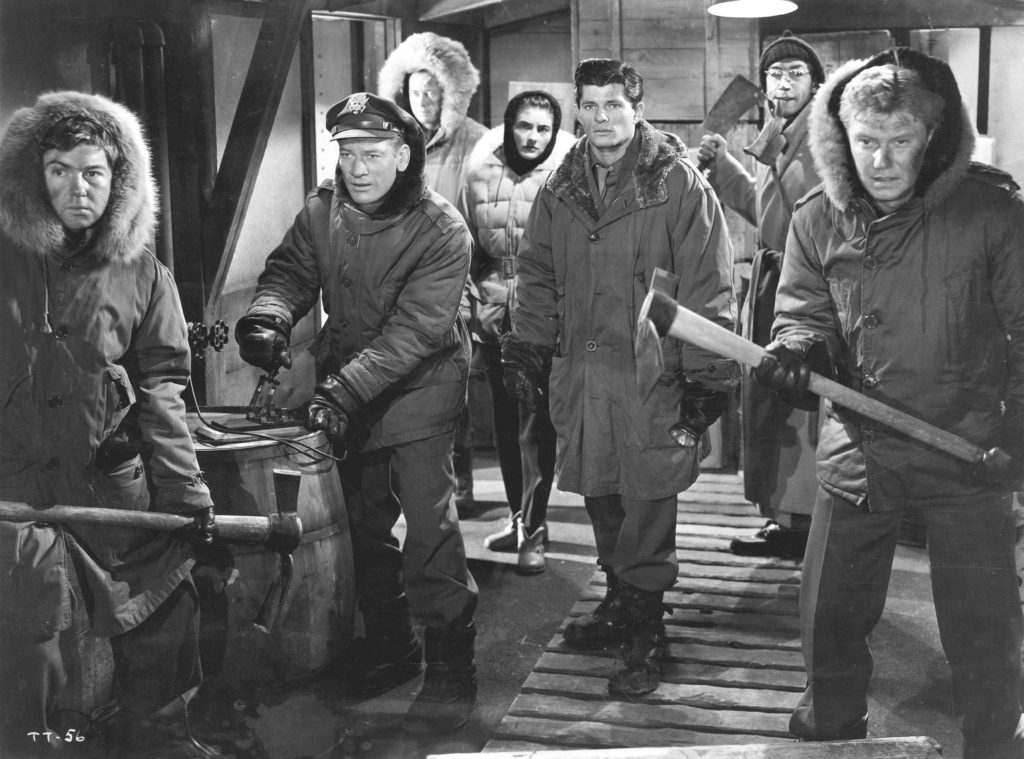
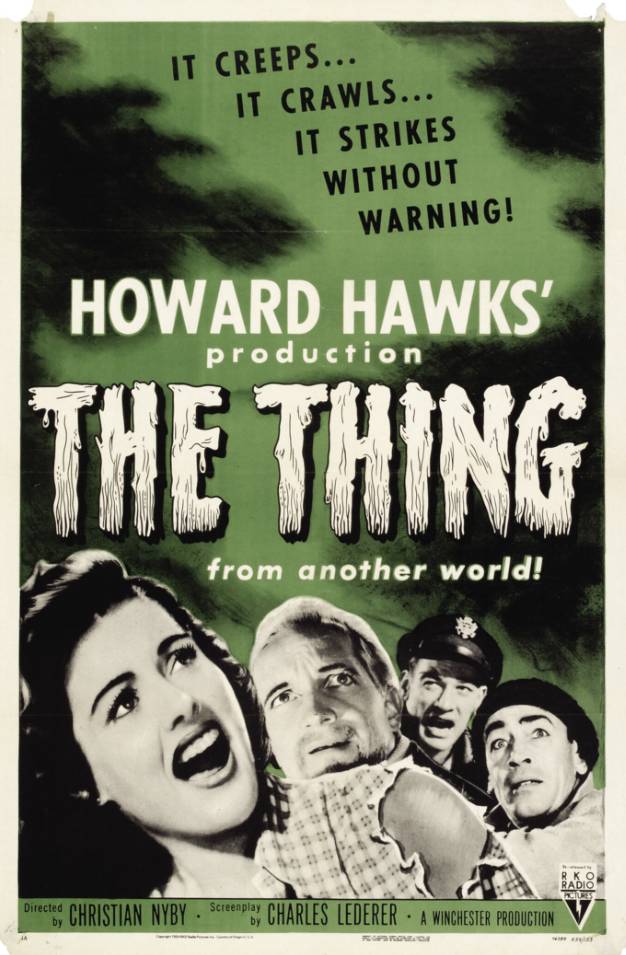

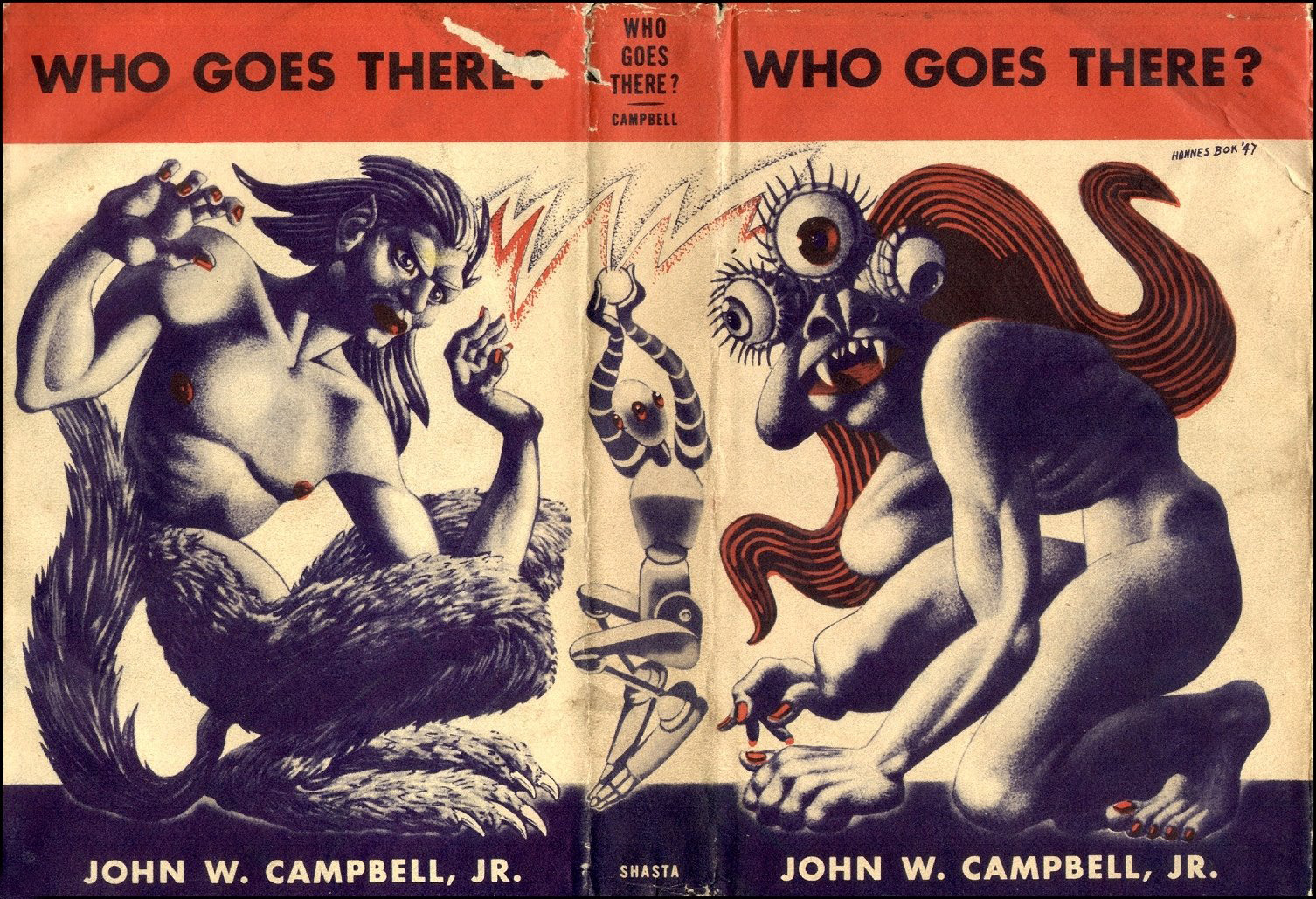

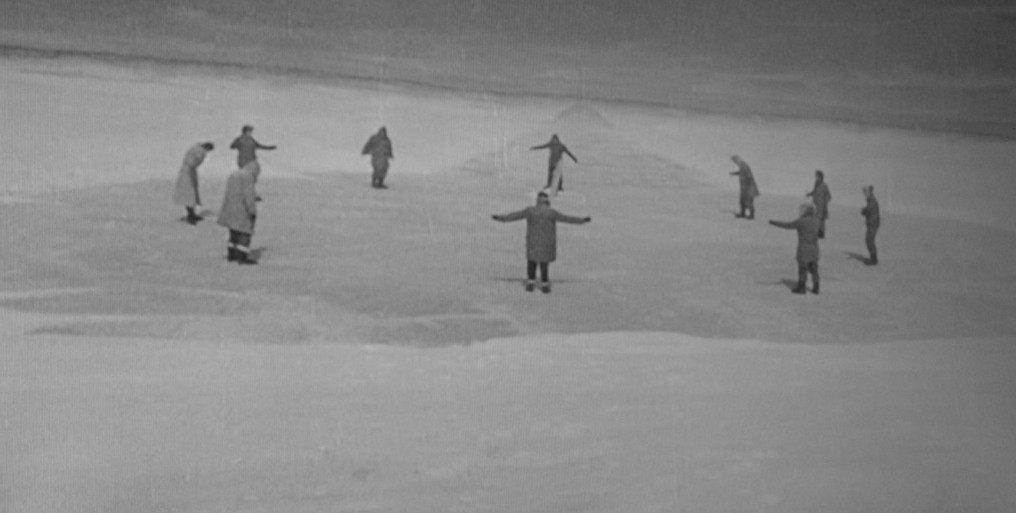



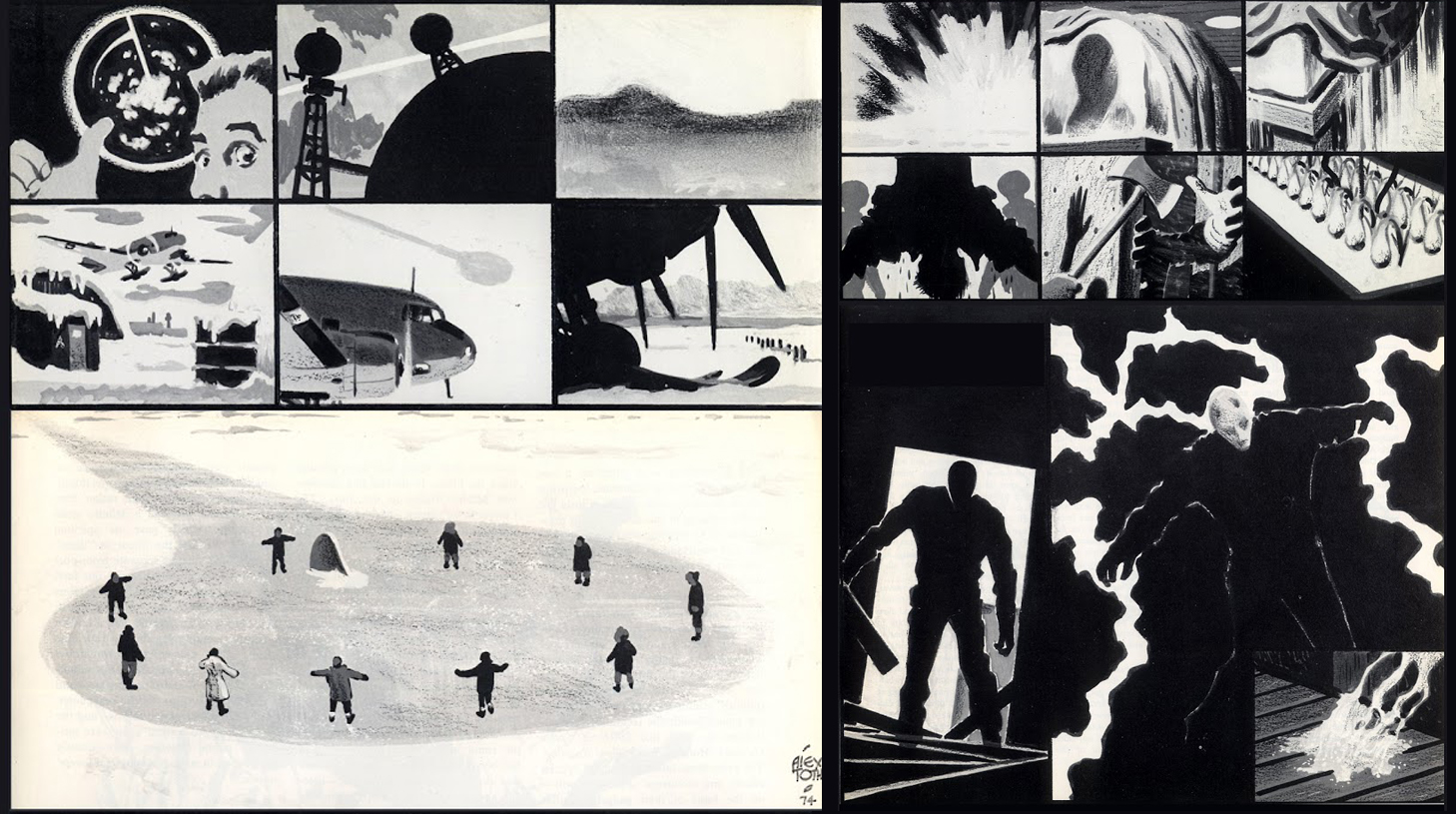

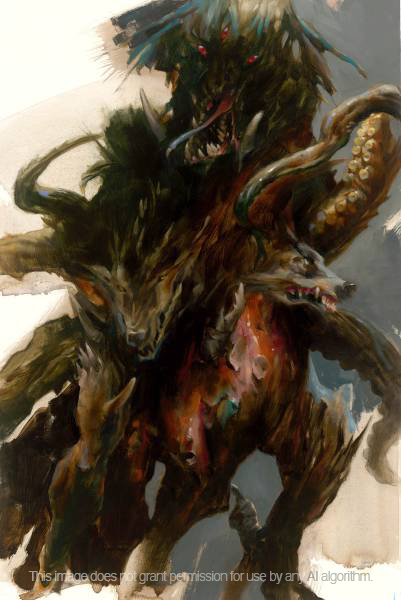





“All the hubbub about the author” is one way to put it. It certainly isn’t the way I’d phrase talking about someone who held his reprehensible views.
John Carpenter’s The Thing was filmed in such a cold desolate place perhaps that influenced the level of paranoia. Bob Martin, the editor of Fangoria said they were drinking moonshine when he was there to interview Rob Bottin and write an article about the filming.
You might be right. I had the opportunity to watch both films recently (TCM runs the Hawks film regularly) and the contrasts were significant: in the first film you get the impression that everybody likes each other (well, except for maybe Professor Carrington and his two subordinates who wind up as alien food) while in Carpenter’s remake no one really seems to like anyone overly much and are fed up with their mission. Which, of course, would reinforce the characters’ suspicions and paranoia as the Thing’s presence becomes knows.
I didn’t realize that the 1972 “Horror Express” was loosely based on “Who Goes There?” I’ve never watched the 2011 prequel, also titled “The Thing,” because at a glance it just seems like more of the same. I’ve heard about an adaptation of “Frozen Hell” is in the works and that Carpenter is also thinking of doing a sequel to his movie; like I said, good monsters never die.
Good grief Arnie! I just watched this film again today and then read your comments on it. I thought, “Fenner has been tapping into your thoughts!” But since you wrote this on October 7th I suppose it’s more likely the other way around. But seriously, I was thinking about the Jim Danforth illustration from Photon and the quote you posted “He’s gonna be mighty mad when he gets to me.” is one I’ve shared on FB as a favorite. I also like Captain Hendry’s when he confronts the lead scientist, “Your friends are hanging up in there like in a slaughter house. I wish you’d seen it!” Every time I watch this it feels like this film gets everything right. A number of years ago I was at a convention in Kansas City talking about the movie with Bernie Wrightson. He was surprised on a rewatching to discover all the snappy dialogue between Kenneth Toby and Margaret Sheridan. I was surprised that he had missed it. Just a wonderful movie with a great cast and I love the way they talk over each other. One other thing: your list of favorites for the season pretty much describes the dvds I have stacked next to my TV right now except I don’t have 5 Million Years to Earth. Do you perhaps have half of a locket given to you by your parents? Or better yet a treasure map? I’ll check to see if I can find mine. 😉 Best wishes and have a great Halloween. P. S. My favorite this year might be Brides of Dracula. We’ll see. I also really enjoyed seeing Night of the Demon again.
just feels like every time
Thanks, Aaron. Yeah, “The Thing” is full of great quotes; Bernie was probably caught up in the pace and suspense when he first saw it as a kid and didn’t catch all of the snappy exchanges. (And didn’t Bernie do some concept art for Carpenter’s film? I seem to remember some drawings.)
There’s always been a certain amount of controversy about who actually directed the film: the style is so much Howard Hawks’ that it’s long been rumored that he gave Christian Nyby the credit so that Nyby could obtain his Director’s Guild membership. Reportedly as the producer Hawks gave Nyby only $5,460 of RKO’s $50,000 director’s fee and kept the rest himself. The cast itself disagreed as to who did what: Kenneth Tobey said that “Hawks directed it, all except one scene” while George Fenneman said that “Hawks would once in a while direct, if he had an idea, but it was Chris’ show.” Robert Cornthwaite said that “Chris always deferred to Hawks … Maybe because he did defer to him, people misinterpreted it” and Bob Self’s grandfather, William, said “Hawks was directing the picture from the sidelines. Chris would stage each scene, how to play it. But then he would go over to Howard and ask him for advice, which the actors did not hear … Even though I was there every day, I don’t think any of us can answer the question. Only Chris and Howard can answer the question.”
I agree! I once had a conversation with artist/writer Adam Rex about the societal fears that are reflected in horror films: fear of “outsiders,” fear of the atomic bomb and radiation, fear of crime, and, of course, the assimilating aliens in “Invasion of the Body Snatchers” have often been seen as an allegory for the loss of personal autonomy and individualism in communism (though Leonard Maltin disagreed and wrote about a McCarthy-era subtext, or of bland conformity in postwar Eisenhower-era America). Different things scare different people. Stephen King once wrote about sitting behind a woman in a theater watching “The Amityville Horror”; during the scene in which blood oozes from the house’s walls and down the staircase King said the woman put her hand to her cheek and said loud enough for him to hear, “Think of the bills!”